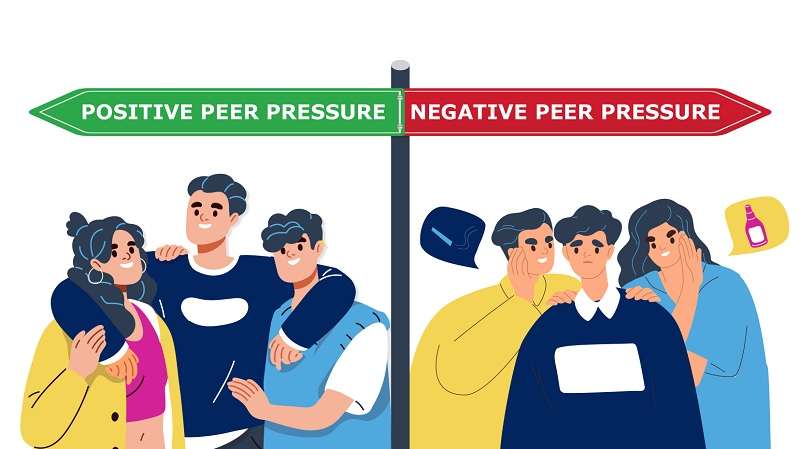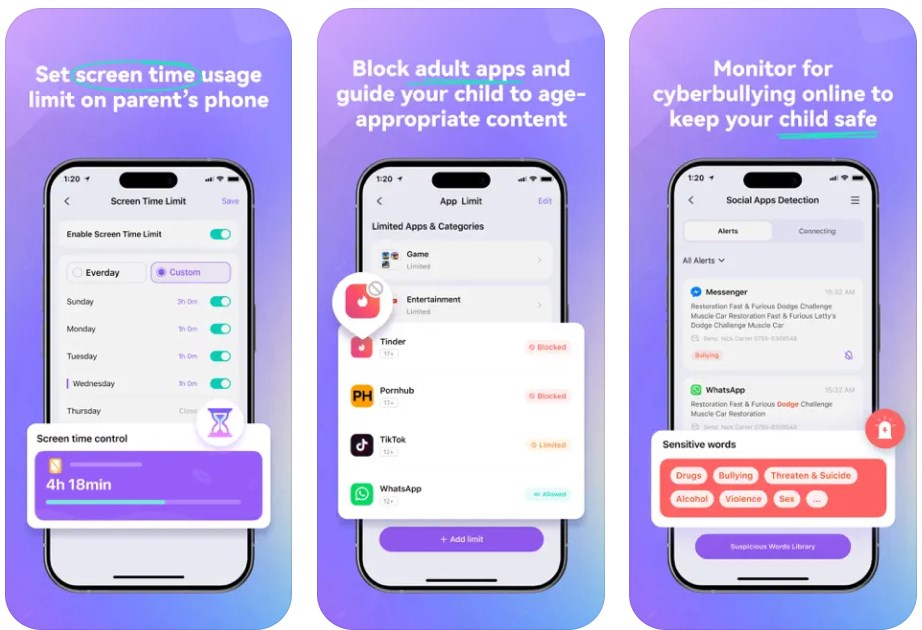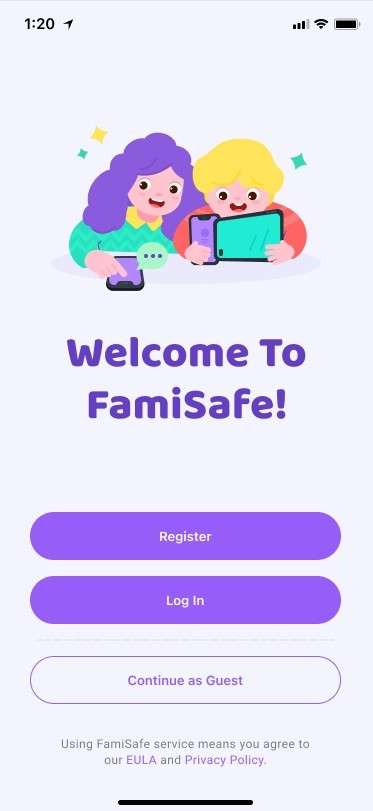
Peer pressure is a common experience among children and teenagers. It's where they feel the need to conform to the expectations of their peers. With the rise of the digital age, the role of technology in peer pressure has become more prevalent. It can be positive or negative, and it can significantly impact the behavior and choices of individuals.
This page will discuss the different types of peer pressure and its effects on young people. The article will also expand on how technology has changed the landscape of peer pressure. By understanding the different peer pressure types, you can help young people navigate the pressures of the digital world. Explore the page below to discover further.
Table of Content
Part I. Decoding the Different Types of Peer Pressure
Peer pressure is the influence to conform to certain behaviors, attitudes, or beliefs exerted by individuals or groups within one's social circle. It can have positive and negative effects, motivating healthy behaviors or leading to risky or harmful ones. Below are the types of peer pressure you should take note of.
Positive and Negative Peer Pressure
Positive peer pressure motivates individuals to engage in healthy or beneficial behaviors. Negative peer pressure, meanwhile, leads individuals to engage in risky or harmful behaviors. Below are examples of both types.

Positive Peer Pressure:
- Encouraging a friend to attend school regularly.
- Motivating a group to participate in a community service project.
| Benefits | Both examples can lead to healthier and more positive behaviors and outcomes. |
| Consequences | Failing to respond to positive peer pressure can lead to feelings of guilt or shame if one fails to meet the expectations of the group. |
Negative Peer Pressure:
- Pressuring a friend to try drugs or alcohol.
- Bullying or pressuring someone to engage in risky behaviors.
| Benefits | Both examples provide a sense of validation or belonging in the short term. |
| Consequences | It often leads to long-term adverse outcomes such as addiction, injury, or legal trouble. |
How do you recognize Positive and Negative Peer Pressure?
To recognize positive and negative peer pressure in children and teenagers, look for changes in behavior or attitude and changes in social circles. Positive pressure can motivate healthy behaviors, while negative pressure can lead to risky or harmful behaviors.
Indirect and Direct Peer Pressure
Indirect peer pressure can be subtle or implicit ways in which individuals influence others to conform to certain behaviors or attitudes. Direct peer pressure, on the other hand, refers to the explicit and overt attempts to pressure others.

Indirect Peer Pressure:
- Wearing certain clothes that your child wouldn't otherwise wear to fit in with a group
- Adopting particular speech patterns or mannerisms to fit in with a group
| Benefits | Both examples provide a sense of belonging and connection to others. |
| Consequences | It can lead to feelings of inauthenticity or pressure to conform to others' expectations. |
Direct Peer Pressure:
- Using force or coercion to make someone do something they don't want.
- Insisting that someone participate in a risky activity.
| Benefits | These examples create a sense of power or control over others. |
| Consequences | It can lead to harm, injury, or legal trouble. |
How do you recognize Indirect and Direct Peer Pressure?
Pay attention to their language and behavior to identify direct and indirect peer pressure in children and teenagers. Direct pressure may involve explicit demands or threats, while indirect pressure may be more subtle, such as a desire to conform to group norms.
Spoken and Unspoken Peer Pressure
Spoken peer pressure refers to verbal requests or demands made by peers. Meanwhile, unspoken peer pressure points to nonverbal cues communicating expectations or pressure to conform. Here are some examples.

Spoken Peer Pressure:
- Asking someone to skip class or break a rule.
- Encouraging someone to try a new activity or join a group.
| Benefits | It facilitates communication and builds relationships. |
| Consequences | It can lead to negative outcomes if the behavior is harmful or risky. |
Unspoken Peer Pressure:
- Laughing at a joke or comment that goes against personal values or beliefs to fit in with a group.
- Engaging in certain behaviors or activities to avoid being left out.
| Benefits | It creates a sense of belonging and connection to others. |
| Consequences | These examples lead to feelings of pressure or discomfort if the behavior goes against personal values or beliefs. |
How do you recognize Spoken and Unspoken Peer Pressure?
Pay attention to their verbal and nonverbal communication to recognize spoken and unspoken peer pressure in children and teenagers. Spoken peer pressure involves explicit requests or demands, while unspoken peer pressure may be conveyed through nonverbal cues or social norms.
Parents need technology to protect their children from adverse online peer pressure. Wondershare FamiSafe is a powerful parental control app that can help parents monitor and manage their children's online activity, block inappropriate content, and track their device usage. Read on below to learn more.

Part II. How Can Famisafe Protect Your Child From Peer Pressure
Your child's safety and well-being are of utmost importance as a parent. With the increasing prevalence of negative peer pressure and other online risks, monitoring your child's device usage and protecting them from potential harm can be challenging. That's where Wondershare FamiSafe comes in.
Wondershare FamiSafe is a powerful parental control app that can help protect children and teenagers from negative peer pressure and other online threats. FamiSafe is available on both Android and iOS devices, and it offers a range of features that can promote healthy device usage and foster positive social connections.

Key Features
FamiSafe offers a range of powerful features that can help you protect your child from negative peer pressure. Here are all of them below.
Browser History Monitoring
FamiSafe allows parents to monitor their children's browsing history. This helps parents identify potential negative influences and risky behaviors.
Screen Time Management
Limiting your children's screen time encourages healthy device usage and promotes better sleep habits.
Geofencing
The app lets you set up virtual boundaries around specific locations, such as schools or parks, and receive alerts when your children enter or exit these areas.
App usage tracking
It allows parents to track their children's app usage and identify which apps are being used most frequently.
Website blocking
FamiSafe allows parents to block access to specific websites and filter out inappropriate content, helping protect children from online risks.
Pricing
Wondershare FamiSafe is available in three price plans for families:
- Monthly Plan: $10.99/Month
- Quarterly Plan: $20.99/Quarter
- Annual Plan: 60.99/Year
How To Protect Your Child From Peer Pressure With FamiSafe
Protecting your child from negative peer pressure is easy with FamiSafe. Here's how.
Step 1: Download and install FamiSafe from the official website, App Store, or Google Play Store on your child's device and your device. Next, sign up for a FamiSafe account on the website or app.

Step 2: Connect your child's phone with a QR or pairing code, then set a PIN to protect your account.

Step 3: Set up the parental controls. They include setting screen time limits, blocking inappropriate content, filtering harmful websites, etc. You can customize these settings based on your child's age and needs.

Step 4: Once the parental controls are set up, you can monitor your child's online activity on your device. FamiSafe allows you to view their browsing history, track their location, and receive alerts if they access inappropriate content or spend too much time on their device. You can also use the app to block negative or toxic contacts and promote healthy social connections for your child.

Pros and Cons
Outlined below are the pros and cons of utilizing Wondershare Famisafe.
Pros
- User-friendly interface: FamiSafe is easy to navigate and use, making it accessible for parents with limited technical skills.
- Comprehensive monitoring and control: It provides various monitoring and control features, including location tracking, screen time limits, and content filtering.
- Cross-platform compatibility: The app is compatible with iOS and Android devices, allowing parents to monitor and control their child's activity across multiple devices.
Cons
- Subscription-based pricing: FamiSafe is not free and requires a subscription to access its full features.
- Web Filter & SafeSearch
- Screen Time Limit & Schedule
- Location Tracking & Driving Report
- App Blocker & App Activity Tracker
- YouTube History Monitor & Video Blocker
- Social Media Texts & Porn Images Alerts
- Works on Mac, Windows, Android, iOS, Kindle Fire, Chromebook
Conclusion
Peer pressure is a pervasive influence in the lives of children and teenagers. It can be positive or negative, direct or indirect, and spoken or unspoken. As parents and caregivers, it is crucial to educate young people about the effects of peer pressure. This helps them develop the skills to resist negative influence and embrace positive behavior.
Wondershare FamiSafe is an excellent tool for promoting positive peer pressure by allowing parents to monitor and manage their children's online activity. With FamiSafe, parents can encourage responsible device usage while keeping their children safe and protected.
